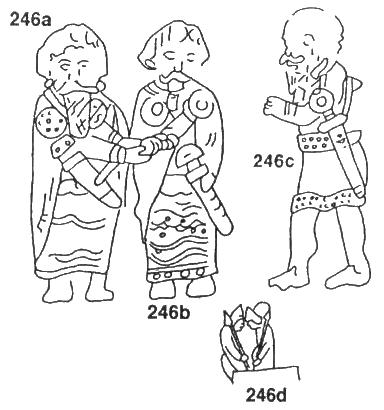Cross of the Scriptures
|
Cross of the Scriptures
|
Detail of shaft reliefs, view from East:
[Top] Christ between Saints Peter and Paul (Traditio Clavium);
[Centre] the Chief Butler before Pharaoh;
[Bottom] Joseph interpreting the dream of Pharaoh’s Butler
Source

A-B - Two chiefs; C - Warrior; D - Sleeping Guards at the Holy Sepulchre. The bishopric of Clonmacnois was one of the main ecclesiastical centres of the old Gaelic kingdom of Midhe. Though the carvings are simple and stylised, they do shed light on 'native' Irish military styles. Here two chiefs, their cloaks held by pairs of massive shoulder brooches, carry short but broad swords. Traditional Irish swords were, in fact, described as having been remarkably short. The weapons appear to have dome-shaped pommels and, in one instance quite clearly (A), to have been suspended from baldrics attached to their scabbards at two separate points. Ireland and the Iberian peninsula were in cultural and religious contact, probably by sea, during the early Christian and early medieval periods, and various aspects of military styles in Ireland, particularly swords, suggest that such contacts may have been maintained on a much reduced scale even after the Islamic conquest of Spain and Portugal. Another carving of a warrior (C) shows a similarly short sword, probably on a baldric, though here the pommel is a large round type. The simple carving of the Guards at the Tomb (D) is almost certainly based on an unrealistic manuscript illumination.